Have you ever dreamed of raising your own chickens, but weren’t sure how to get started? Do you want to know if chickens are the right pet for you? Are you wondering if chickens are safe to raise around kids? Today, Leslie Alvis, our resident crazy chicken lady, Creative Team member, and homeschooling and homesteading mom of four is sharing her love of chickens with you. Leslie grew up raising chickens, had a long chicken drought during college and early motherhood years, but has started up a backyard flock again with her own children. This makes her the perfect person to share, tips, essentials, and all the ins and outs of raising chickens with kids.
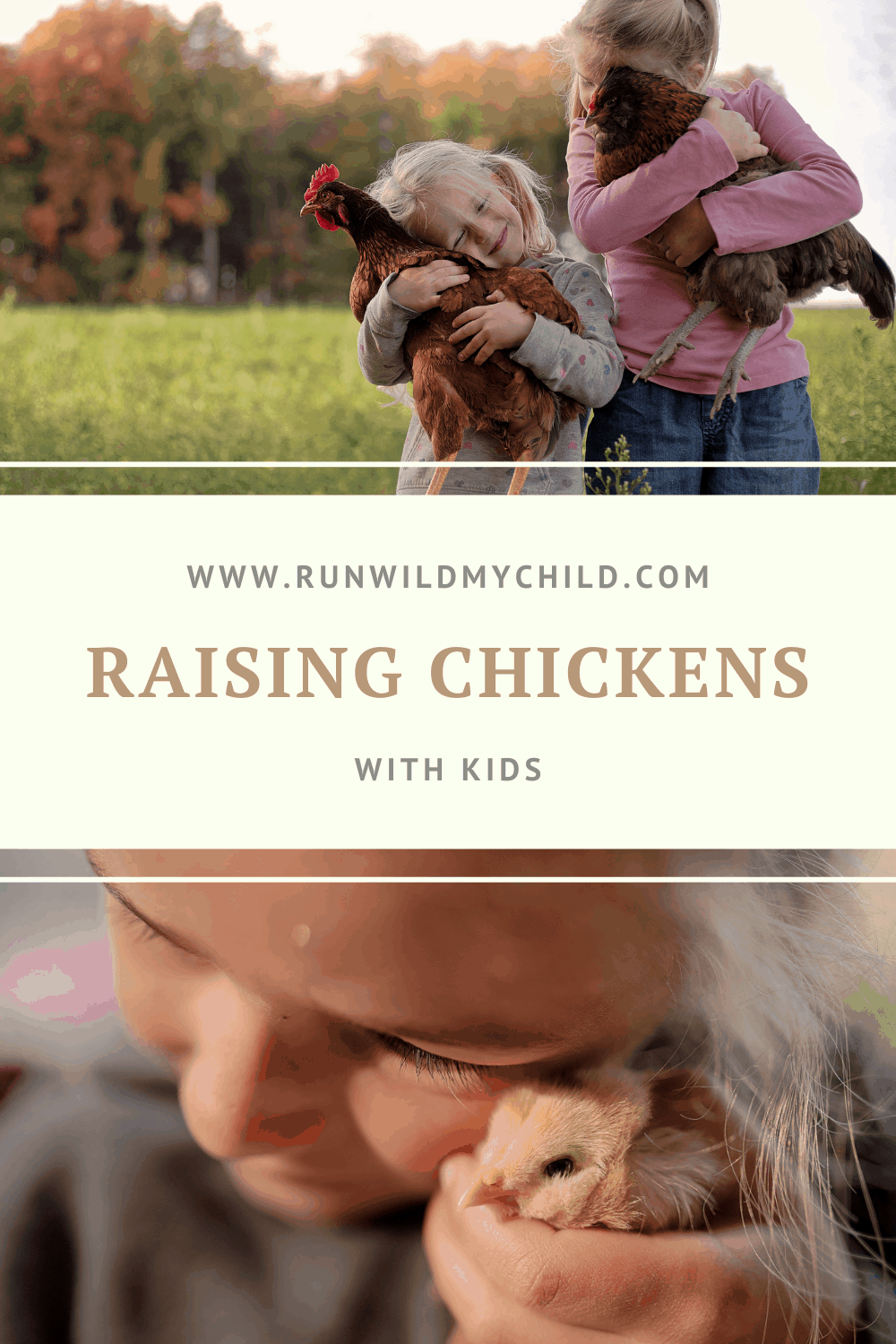
The beginnings of a chicken mama
I was seven or eight years old when the first chicken arrived in my life. My parents were both veterinarians and our farm was often the rehoming site for a variety of animals. Pecky, a stately Light Brahma Rooster, came to us because his elderly owner couldn’t keep up with his antics. I fell in love.
I loved his silky feathers, his majestic red comb and dangling wattles, his audacious crow, his feathered feet. It wasn’t long before I decided he needed a family, and so it began. We bought some hens from the little lady who sold eggs just down the road. Soon I was showing chickens in 4-H and selling eggs.
My little flock grew quickly and I loved every member of it. All my chickens had names and personalities. They roamed our barn and yard, providing us with multi-colored and multi-sized eggs and endless entertainment. At one point, my mom clipped an article from a local titled, “Chickens: Better than Television,” and stuck it on the refrigerator. It was true for our family. The chickens were my responsibility, but they entertained us all.
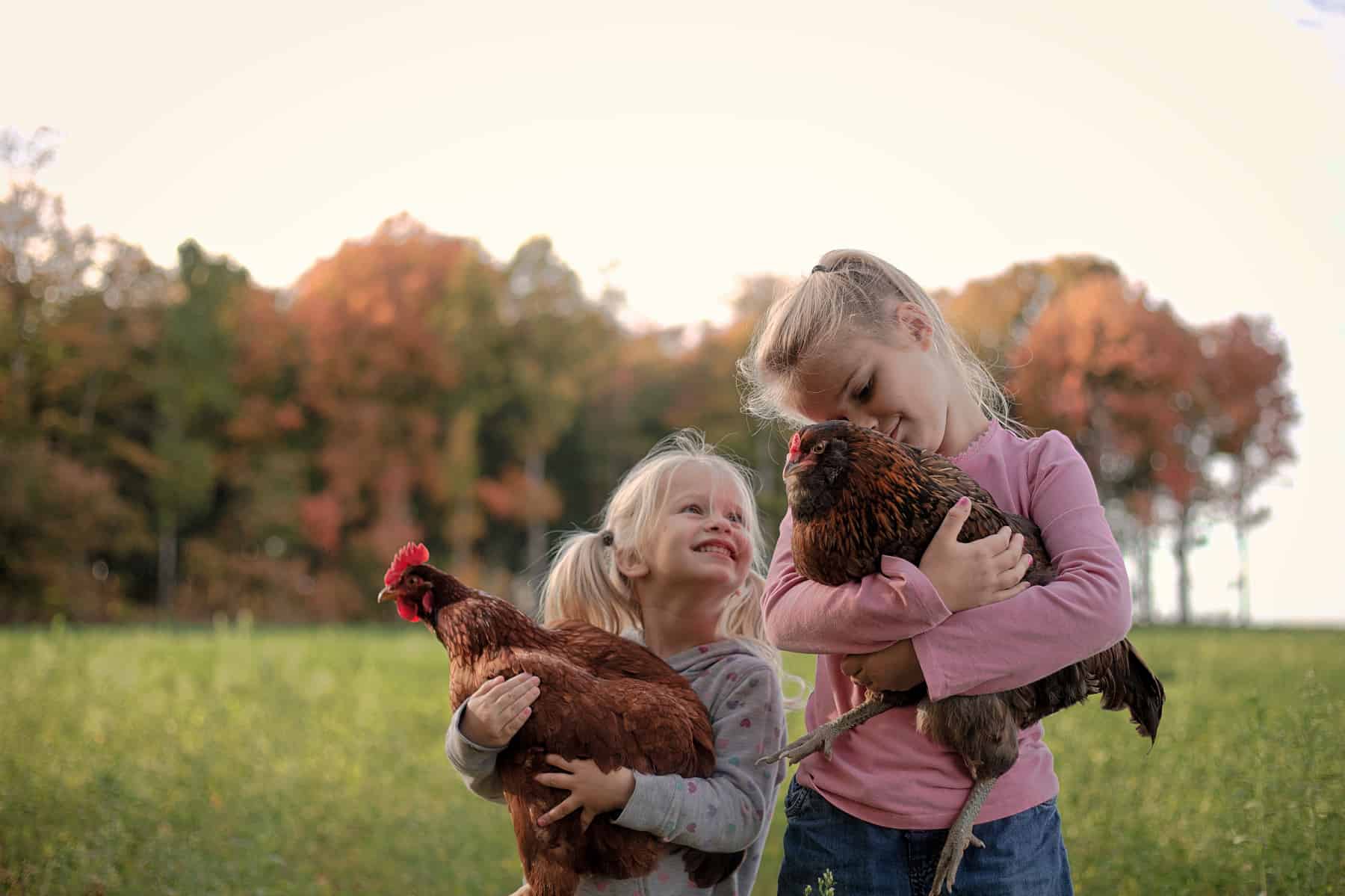
Raising chickens with kids
After years of living in a town where we weren’t allowed to raise chickens, we now live in the country and my children are helping me build a flock again. We started with 11 chicks last spring, and just added 13 more. My daughter gleefully announced recently that right now we have three separate flocks: the grown hens, the adolescent chicks, and the newly hatched Ameraucana chicks I couldn’t leave the feed store without last week.
I’m a firm believer in the benefits of kids raising kids with animals. Taking care of animals helps children learn responsibility, gentleness, and the importance of looking after other living things. They learn empathy and compassion. They also get to experience the joy of friendship with those animals. So, although my older kids have their own pets they’re responsible for and I’m the person primarily responsible for the chickens, I make sure all my kids are involved in our chicken raising adventure.
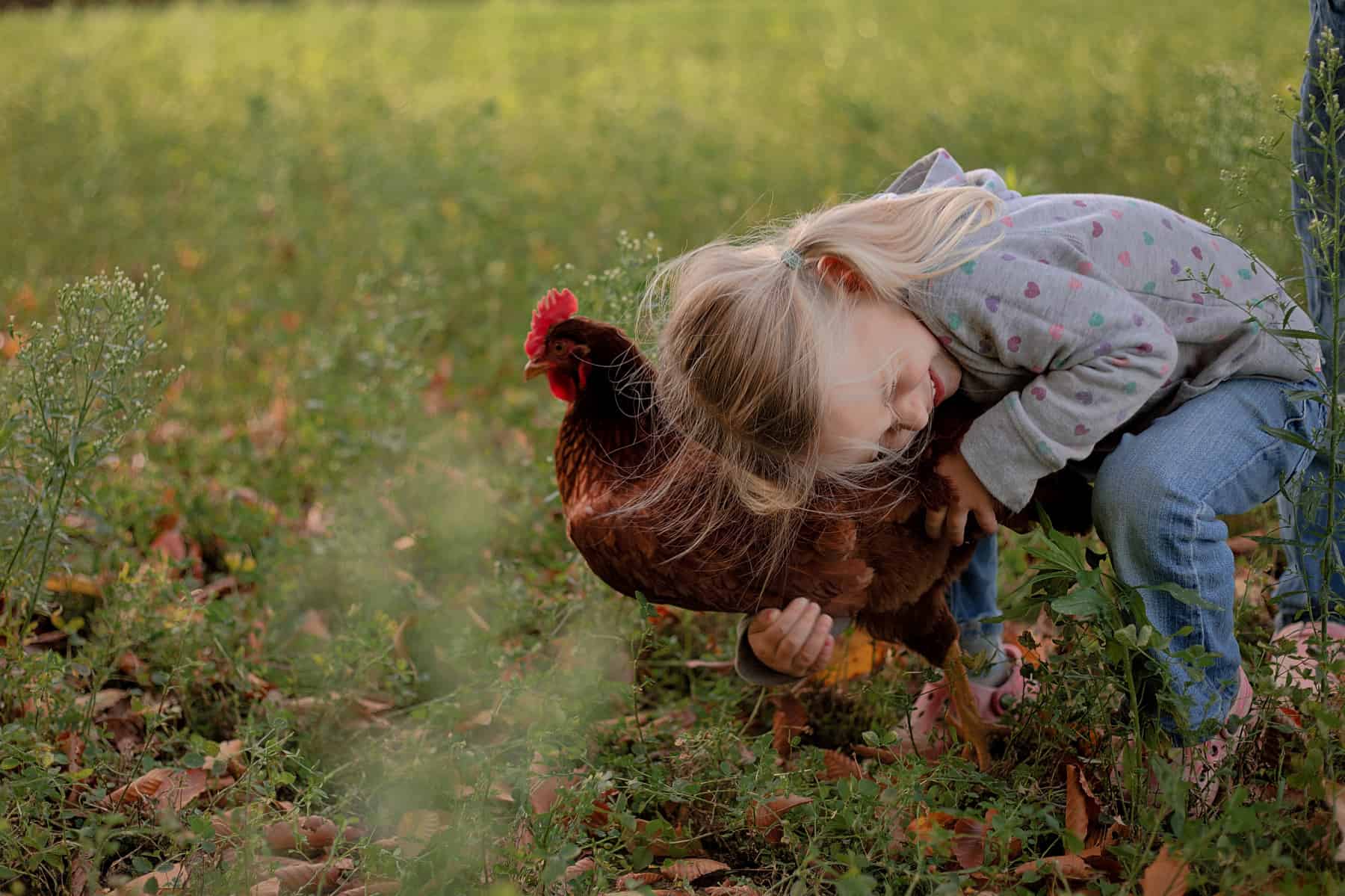
The joys of chickens
If you’re looking for a pet that’s both productive and personable, you really don’t need to look any farther than a chicken. These feathered friends are relatively simple to care for, make enjoyable pets, and a good laying hen will reward you with up to 300 eggs a year! They’re also pets that children of every age will enjoy.
Our children (ranging in ages 3-13) all help me with different parts of the chickens’ care on a daily basis. While they may grumble sometimes about chasing the chickens out of the neighbors’ yard again or running out to lock up the coop at dark, they truly enjoy these quirky birds. Everyone loves how the hens come running when we bring them food scraps. We’re mesmerized by the soft fluff of the baby chicks. And the daily wonder of finding fresh brown, green, and blue eggs never wears off.
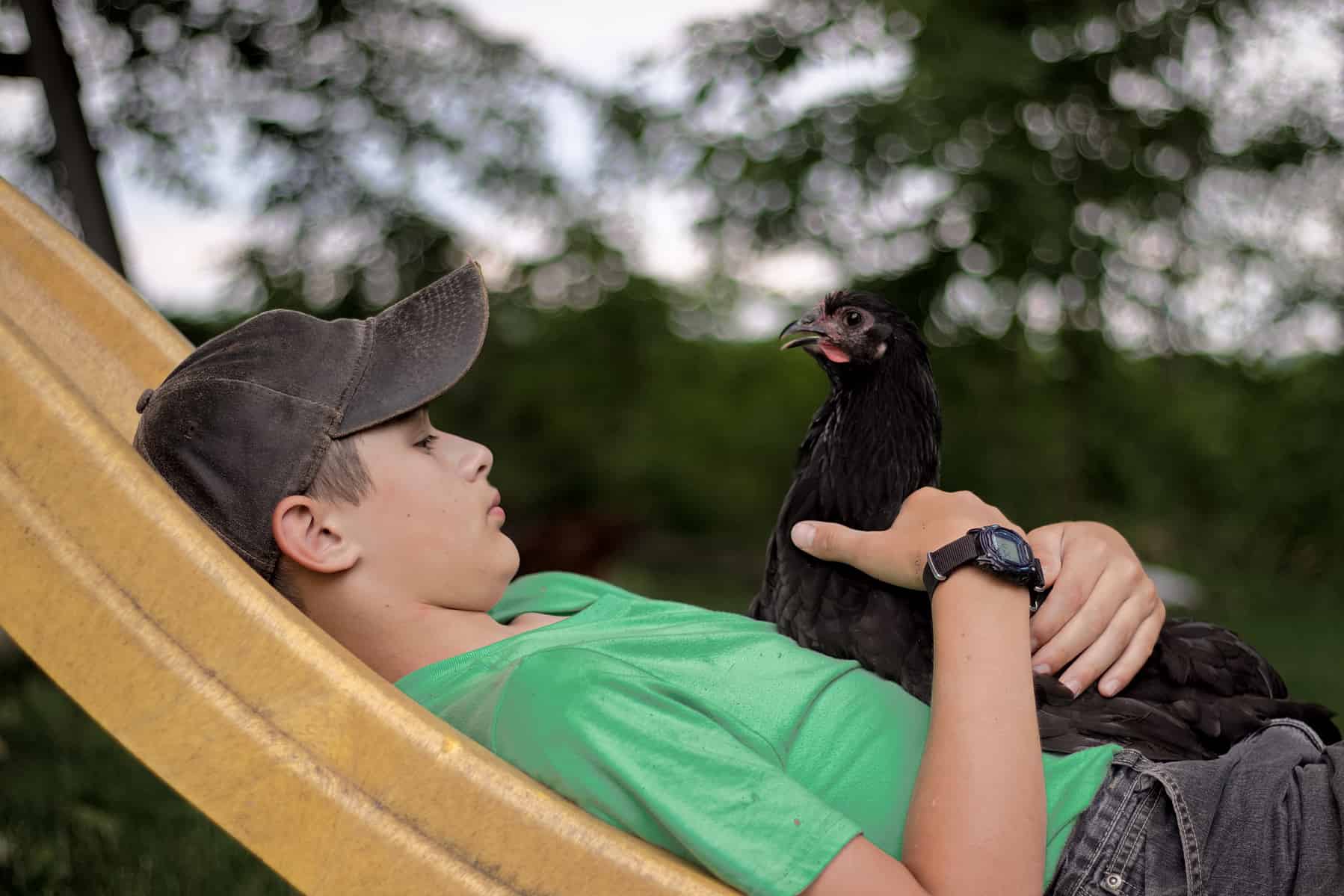
A family affair
Our teenage son might complain that chickens aren’t very smart, but he’s the first person to help me solve a problem with laying boxes or roosts or leaking waterers. And even our three year can march out in the yard and catch a chicken, which delights her endlessly. My husband recently asked if he had to start cheeping to get any attention around here. And if you come visit our house, consider yourself forewarned: at least one, and possibly several, of my children will surely thrust a chick in your face, and expect you to be as delighted with it as they are. A full-grown hen may quite possibly appear also. In the house. Just so you know. Welcome to our zoo.
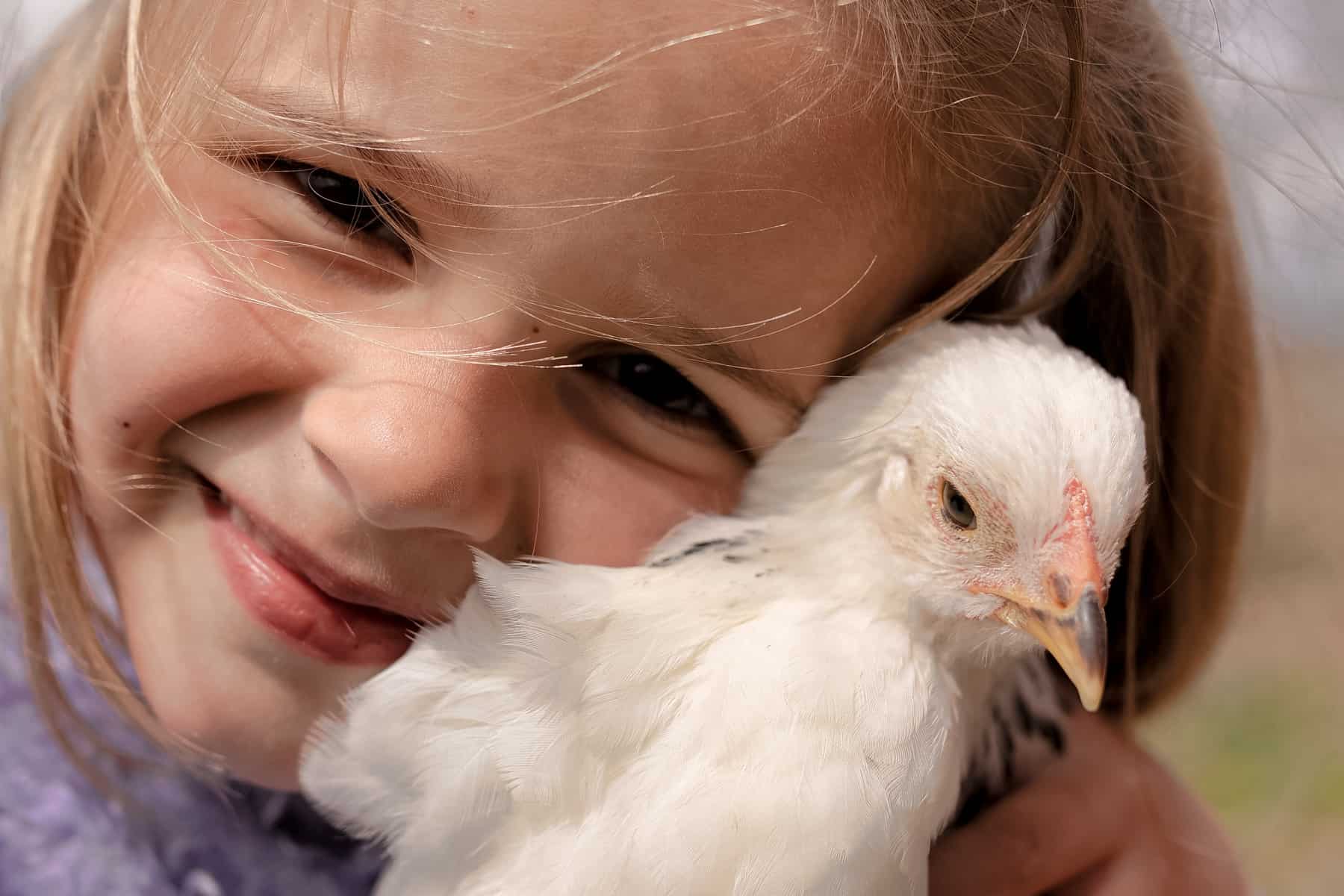
Getting started raising chickens
If you’ve never raised livestock, getting started raising chickens might feel intimidating. Chickens aren’t terribly hard, but there are a few details to consider first. As with any pet, you need to make sure you can provide what chickens need.
The first thing you should do is make sure chickens are allowed where you live. Many towns and cities have allowances for small backyard flocks, but it’s always a good idea to check your local ordinances if you live in a suburban area.
Chickens also need some yard space, whether you intend to let them free-range around your yard, or keep them in an enclosure. You can also do a hybrid of the two: we have an enclosed run to keep the chickens contained when we’re not around. Usually, in the afternoons and evenings, we let them free-range around the yard. They carry a special affinity for the neighbor’s yard, however, so we have to keep an eye on them. When we finish building our homestead, they will have plenty of space to roam freely.
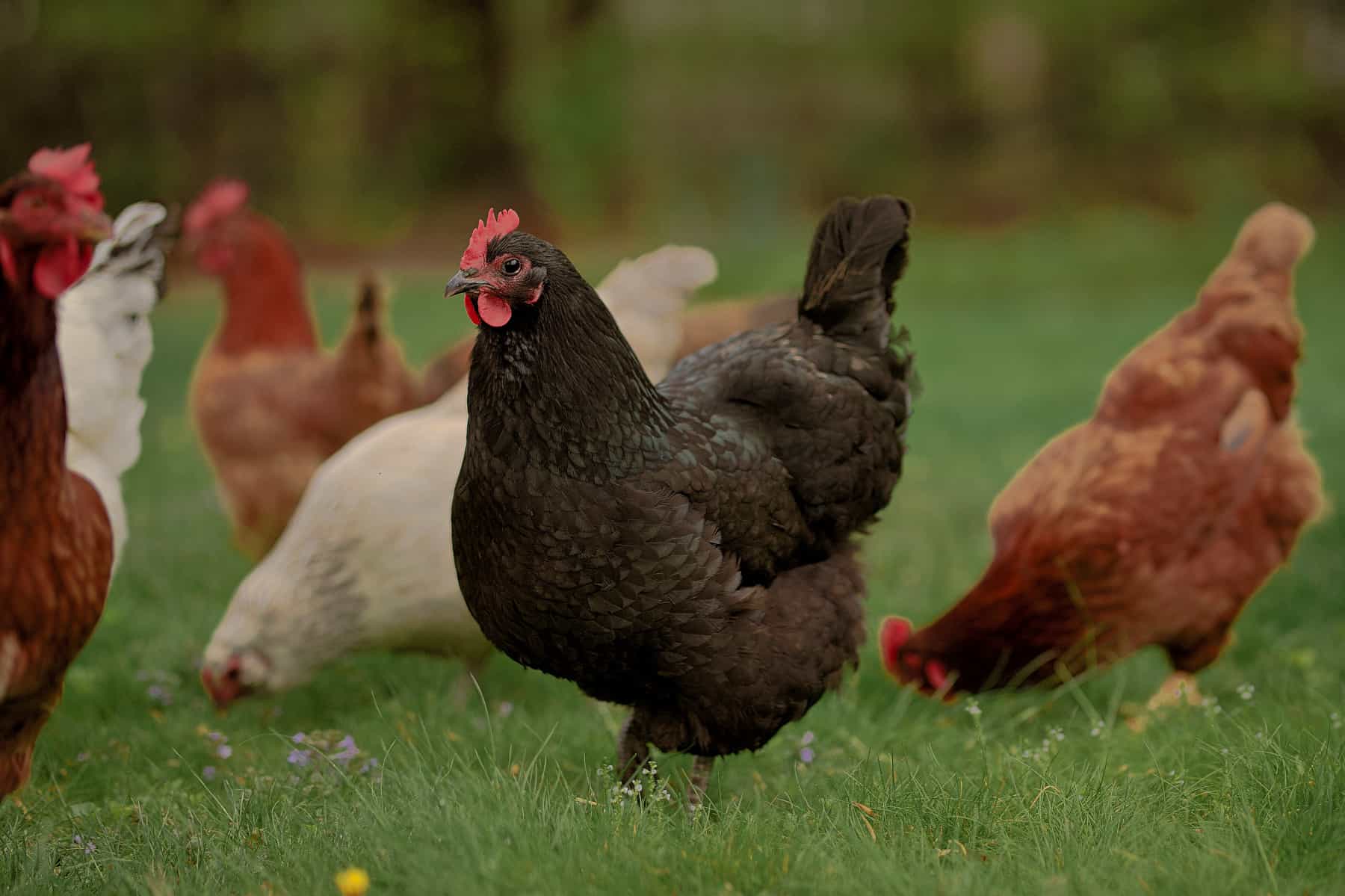
Coop details
Next, you need a secure, draft-free coop for your birds. A general guideline is to allow 2-3 square feet of coop space per chicken. You can buy really cute little coops for a small flock, like this one. If you or someone in your family is up for a bit of a project, check out these great chicken coop plans! My skilled carpenter husband built us a coop out of scrap and repurposed materials. We use a movable dog kennel for our run enclosure.
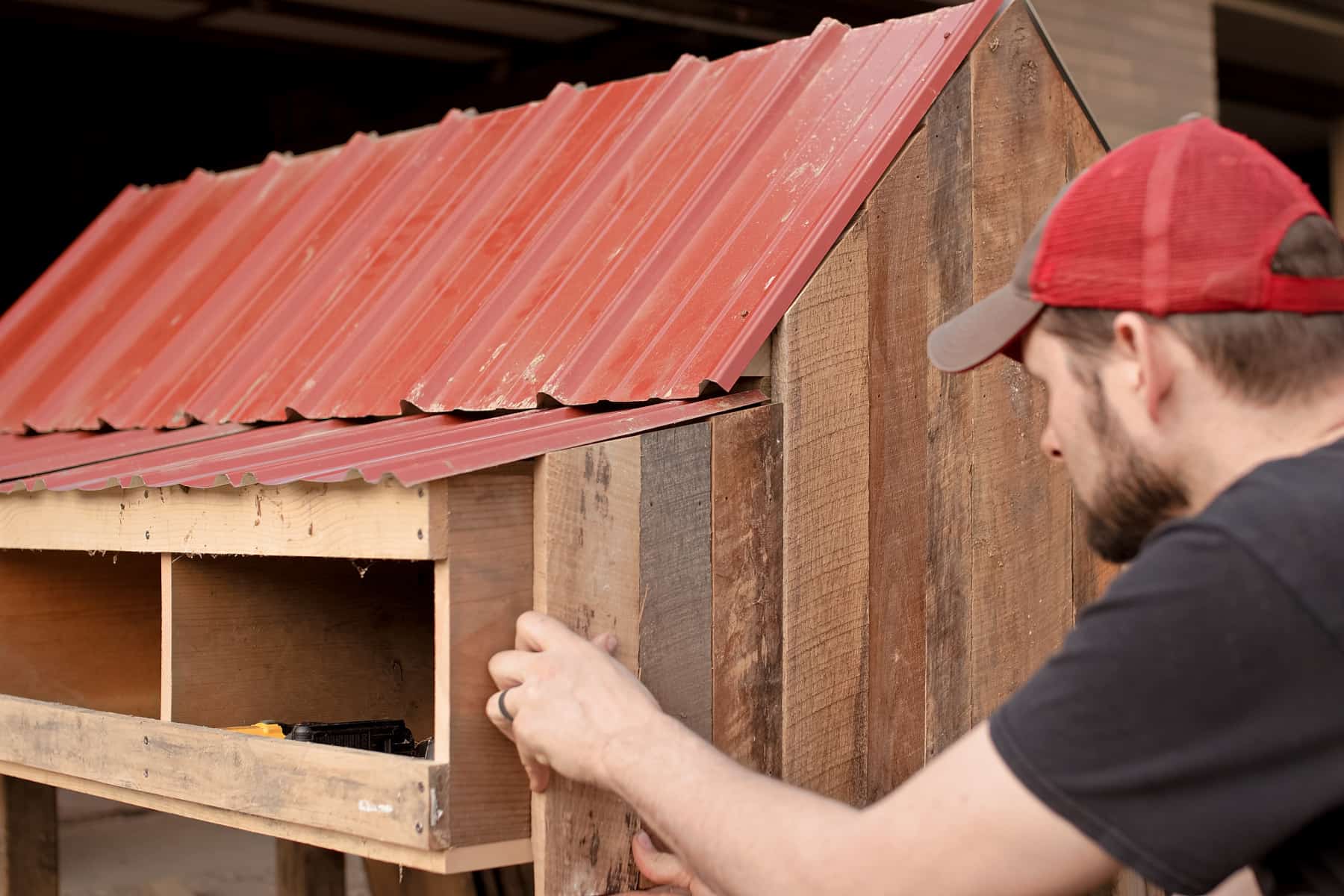
What you need for baby chicks
But before you get overwhelmed by coop details, take a deep breath. If you’re planning to start with baby chicks, all you need to get started is a deep cardboard box for a brooder. Baby chicks need a cozy, draft-free environment and not too much space to start off with. For the first two weeks of their life, baby chicks only need 6 square inches of space per chick. (But don’t put off the coop plans—these little chicks grow fast!)
In all honesty, we’ve kept baby chicks in roomy boxes in our laundry room, basement, garage…even in the living room. Yes, I’m really that crazy chicken lady. I always prefer to keep the tiny peeps close for a while. Besides, we all just want to hold those little fluffballs every chance we get.
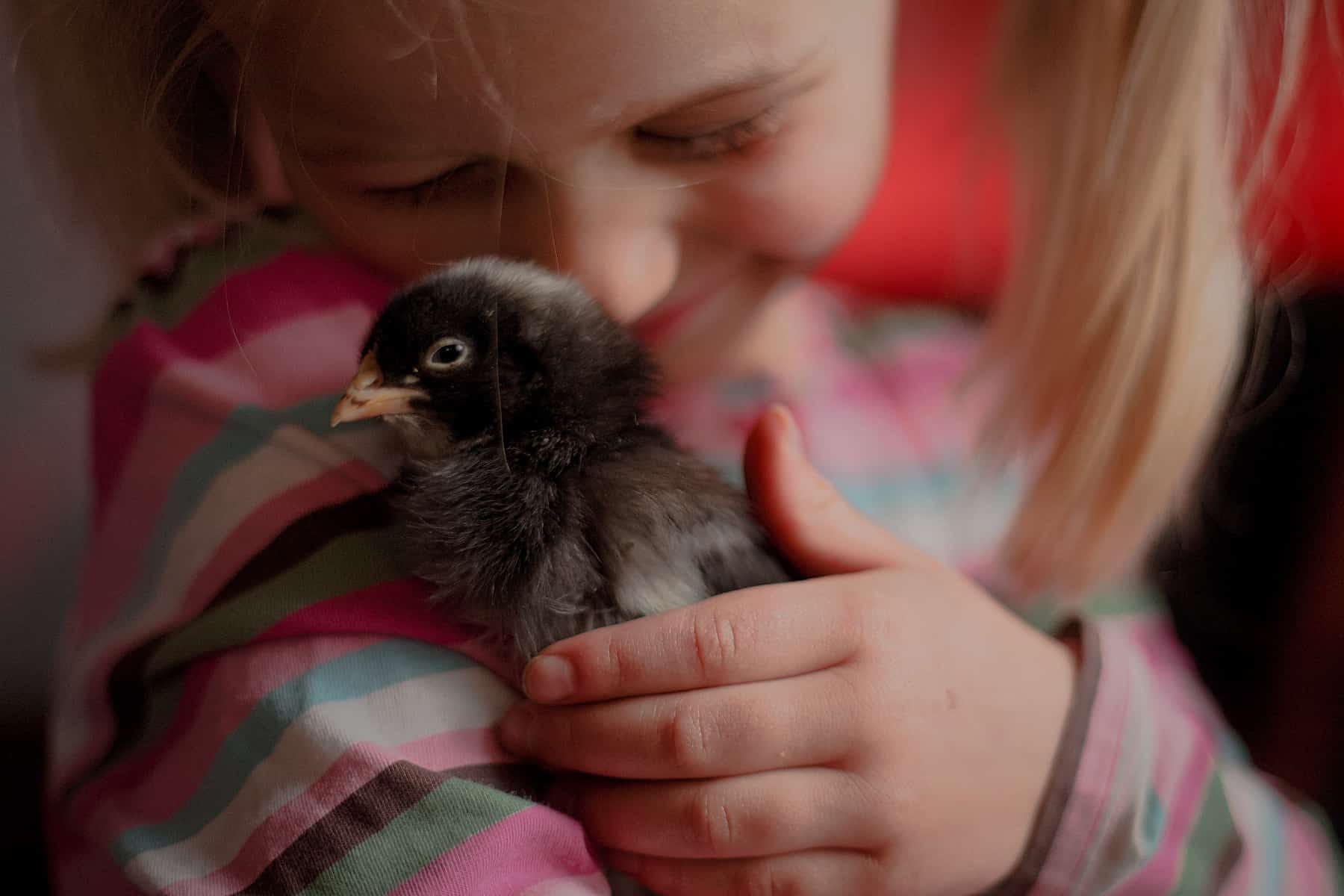
Chicken brooder set up
Getting your brooder set up isn’t hard. Get a nice-sized, sturdy box or build your own, line it with newspaper and pine chips, and hang a heat lamp overhead. A red bulb for your heat lamp helps keep chicks from pecking at one another. The heat lamp should be 18-24 inches away from the chicks. Initially, the ideal brooder temperature is between 90-95 degrees (think body temperature–a mother hen spends most of her time keeping her chicks at her own body temperature).
I always count on the chicks to let me know where it needs to be: when they are cold, they huddle together directly under the heat source. If they’re too hot, they pant and try to get away from it. I watch them very carefully the first few hours after adjusting the heat lamp, to make sure they are comfortable. Although chicks are surprisingly tough and resilient, the wrong temperatures can cause stress and illness. I also arrange the brooder so there is a warm side and a cool side, keeping the food and water on the cooler side.
Additional chicken accessories
If you’re raising chickens, you’ll also need a chick feeder, a waterer, and chick starter feed, which has a higher protein level than adult chicken feed, along with other essential nutrients for healthy chicks. Although you can purchase everything online, I highly recommend using your local farm or garden supply store as much as possible. Not only are you supporting a local business, but you are also tapping into a valuable resource.
A local feed store has knowledgeable employees who can often answer questions for you, as well as competitive prices on everything you need. You’re going to need a regular supply of feed. And if you should ever need medication or supplement for your chickens, you’ll already know right where to find it.
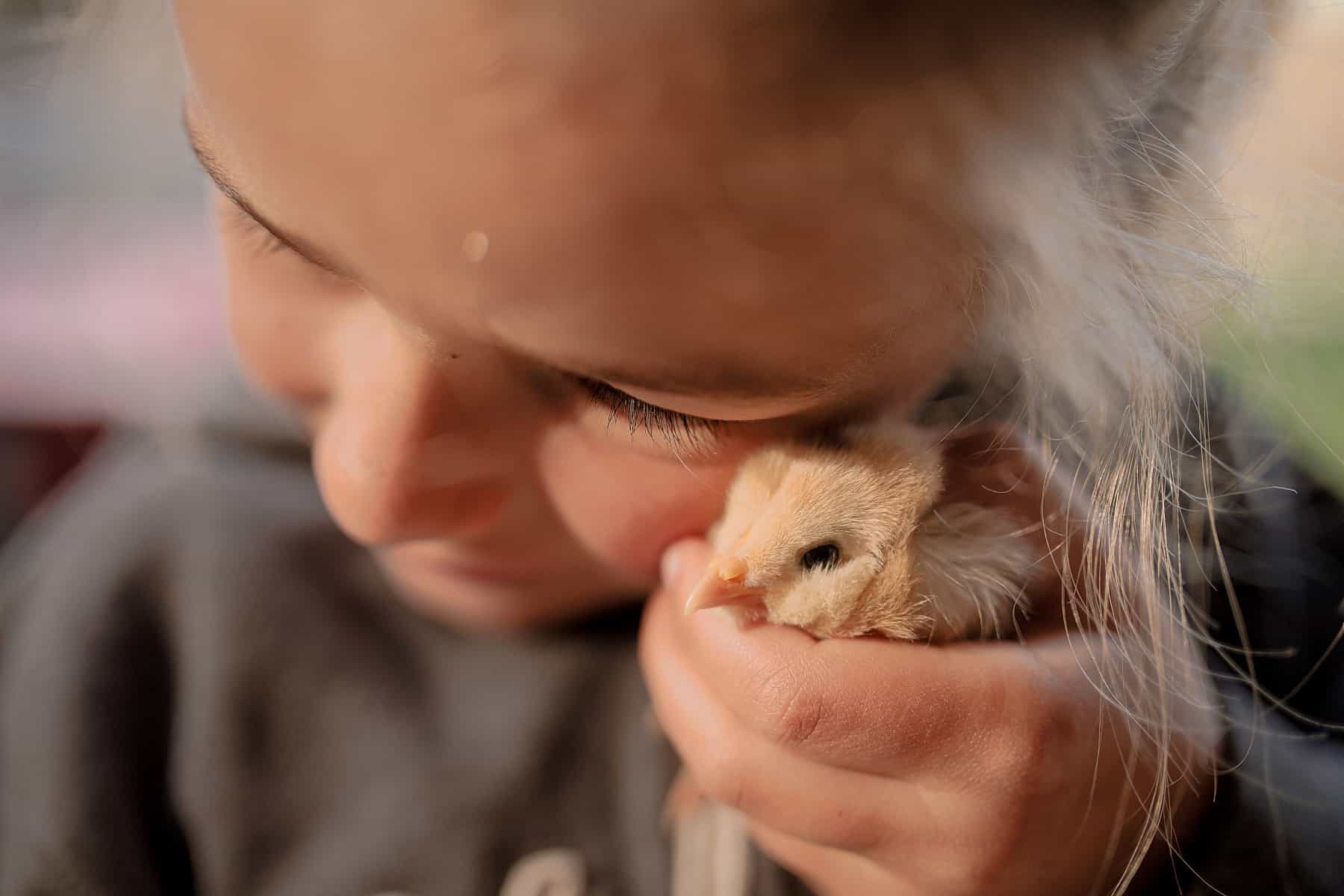
Getting your chicks
Now comes one of the most fun parts of raising chickens: getting your chicks! Once again, you can order chicks online from a hatchery, but you usually have to order at least 25 chicks so they can keep each other warm during shipping. And in my mind, nothing beats picking out those chicks in person. For years, we passed by the chicks at our local feed store on our way to the dog food aisle. We looked longingly into each brooder and told our children, “Someday we’ll live in a place where we can have chickens.”
Last year, just a couple of weeks after moving to our country home, we marched our whole family into the feed store and hand-picked our chicks. It was addictively fun. So fun, in fact, that we couldn’t wait to do it again this year. We talked about it for months, even as we enjoyed raising our bigger chickens. There’s just nothing like getting baby chicks.
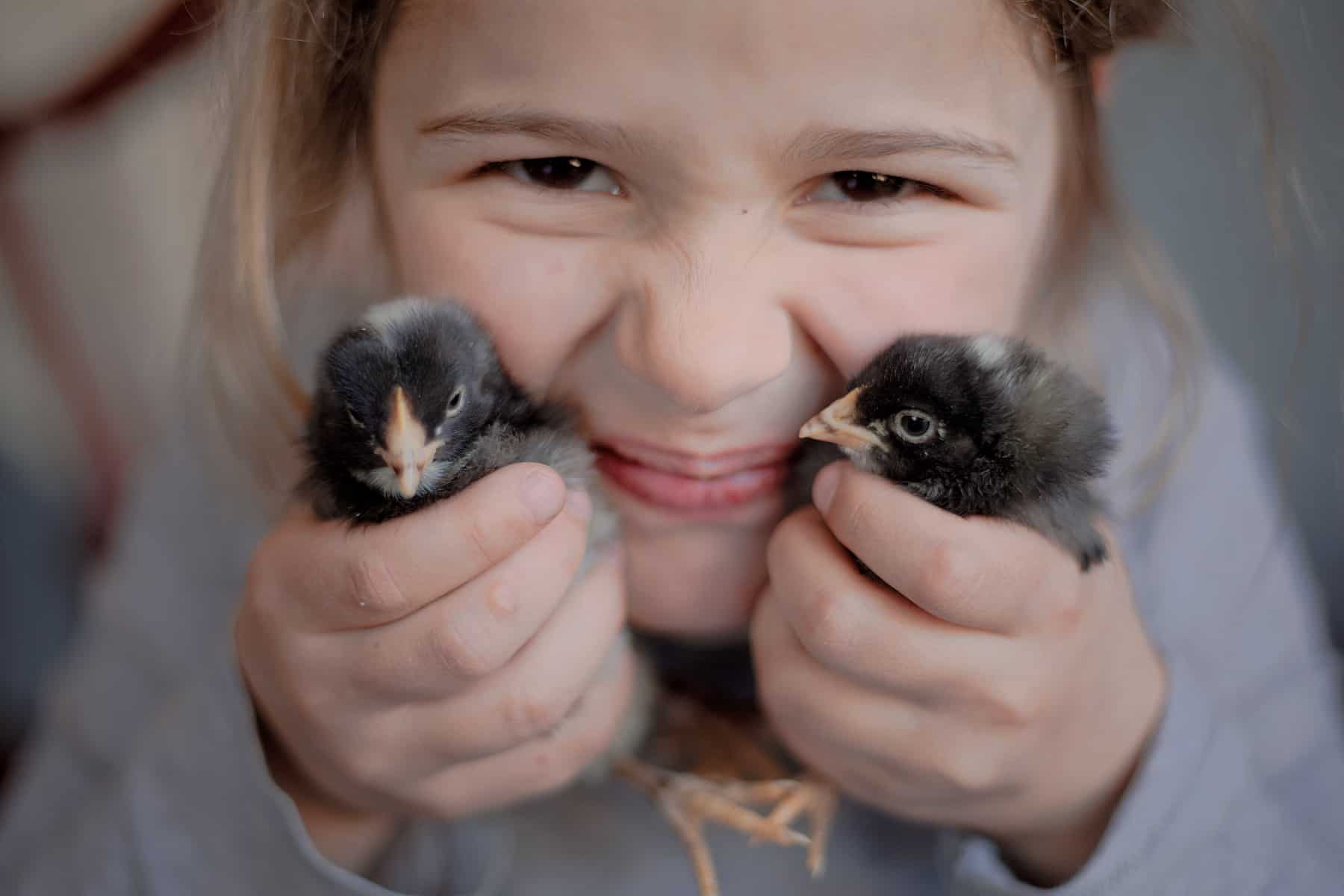
Chicken breeds
What breed of chicken you choose really depends on what you’re looking for. Do you want lots of eggs? Brown eggs? Blue and green ones? All pullets (young females), or straight run (a random mixture of males and females)? Docile chickens? Just bantam chickens who look cute? The options are endless, even at a feed store.
If you look in a hatchery catalog, there are more breeds than you can ever imagine. This article has quite a bit of helpful information about the best laying hens, while this one highlights some of the most kid-friendly chicken breeds. And if you’re interested in different breeds based on the different colors of eggs they might lay, check out this article.
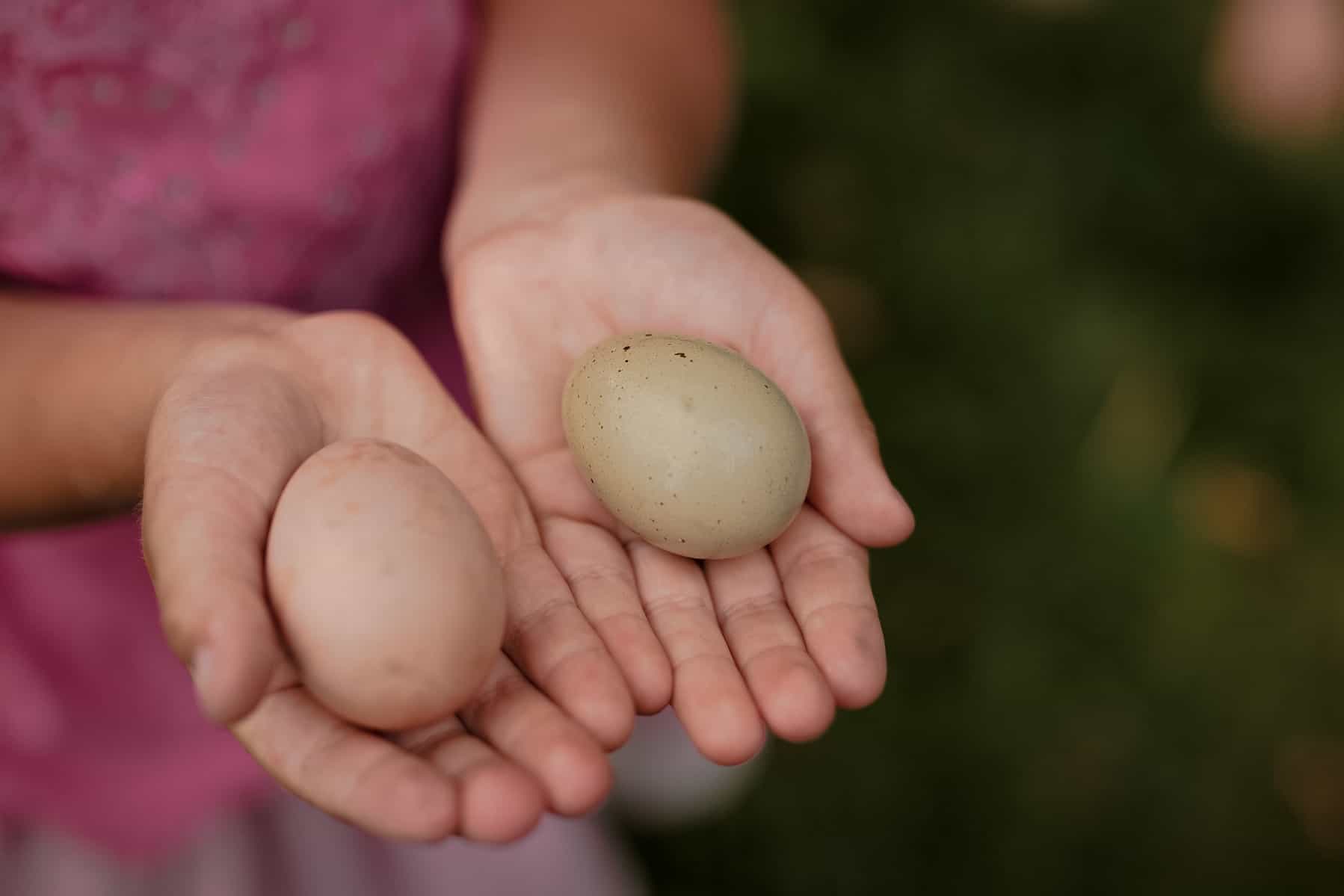
How to pick your chicks
When picking out chicks, we’ve used several different criteria. First, my husband’s vote was that he wanted to see lots of variety in our flock. So we’ve picked several different feather colors. I wanted different shades of eggs, so I picked out brown, green, and blue egg-laying chickens. I also selected some breeds because of their reputation as docile and family-friendly birds.
So our entire family trooped around the chick display, saying, “We want some of those, and a couple of those, and a couple of those…” And we love what we’ve ended up with. Our current laying flock has 3 Ameraucanas, 1 Black Australorp, 2 Light Brahmas, and 3 Rhode Island Reds (we actually got the Reds by accident—they were mixed in with some other chicks. I wouldn’t have necessarily picked them, but they are excellent layers and have also become great pets). This year we picked up some Barred Rocks, ISA Browns, more Ameraucanas, and some bantams for the pure fun of their personalities and plumage.
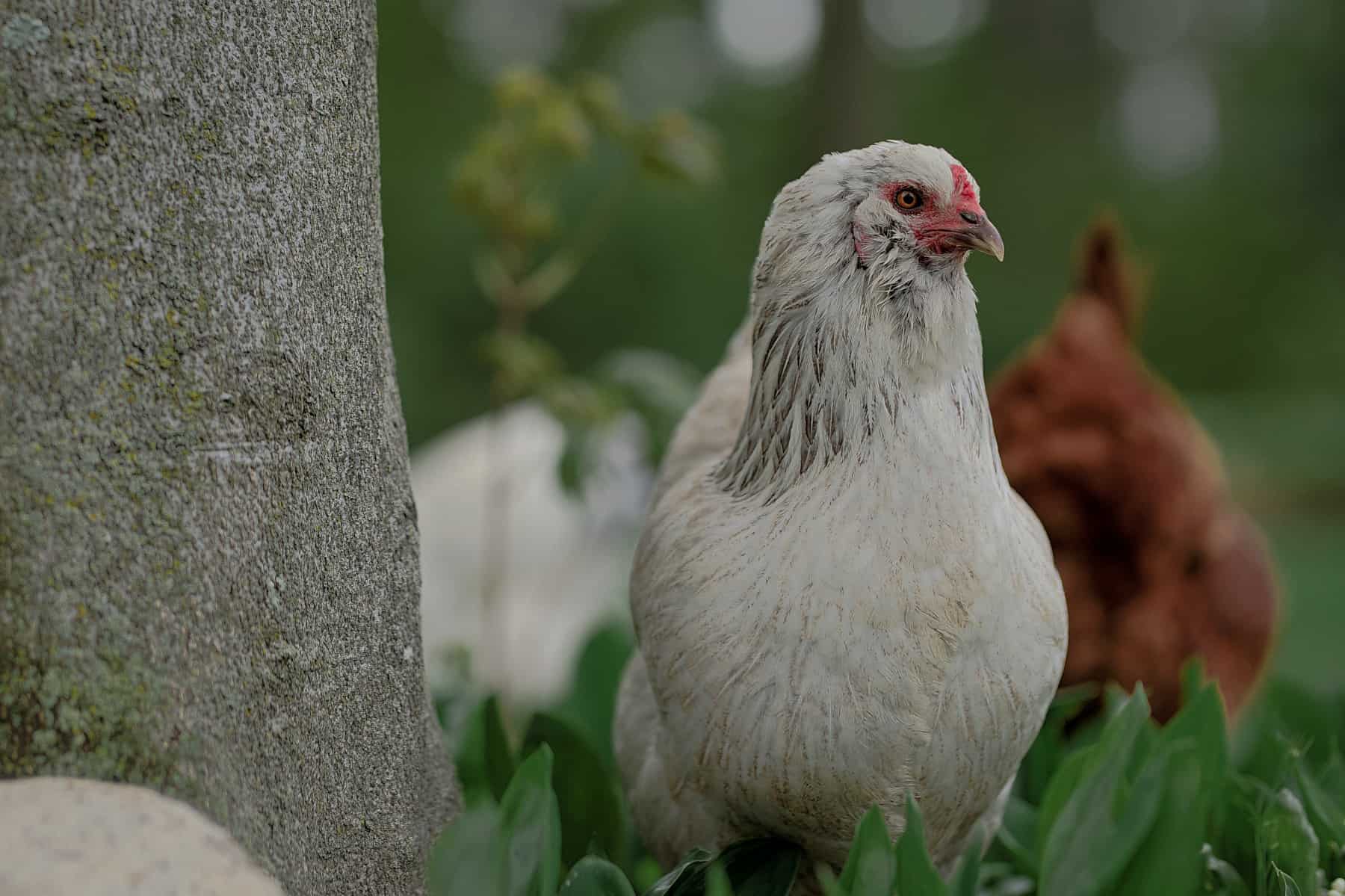
Caring for your chicks
After you get your chicks set up in their brooder, they need what any other animal needs: freshwater, food, and clean bedding. Chicks are messy little critters who love to scratch around. They will kick food and chips into their water, so I try to hang waterers when I can, or at least set the waterer up on a wooden block so it’s slightly elevated. You want to make sure they can still reach it, though! The kids love helping me make sure the chicks have plenty of food.
If your chicks are cheeping loudly, they are probably hungry, thirsty, or too hot or cold. Noisy chicks need attention. The conversational chirping of contented chicks is very different from the yelping cheeps of uncomfortable ones. I can tell as soon as I walk into the room if my chicks are uncomfortable or upset.
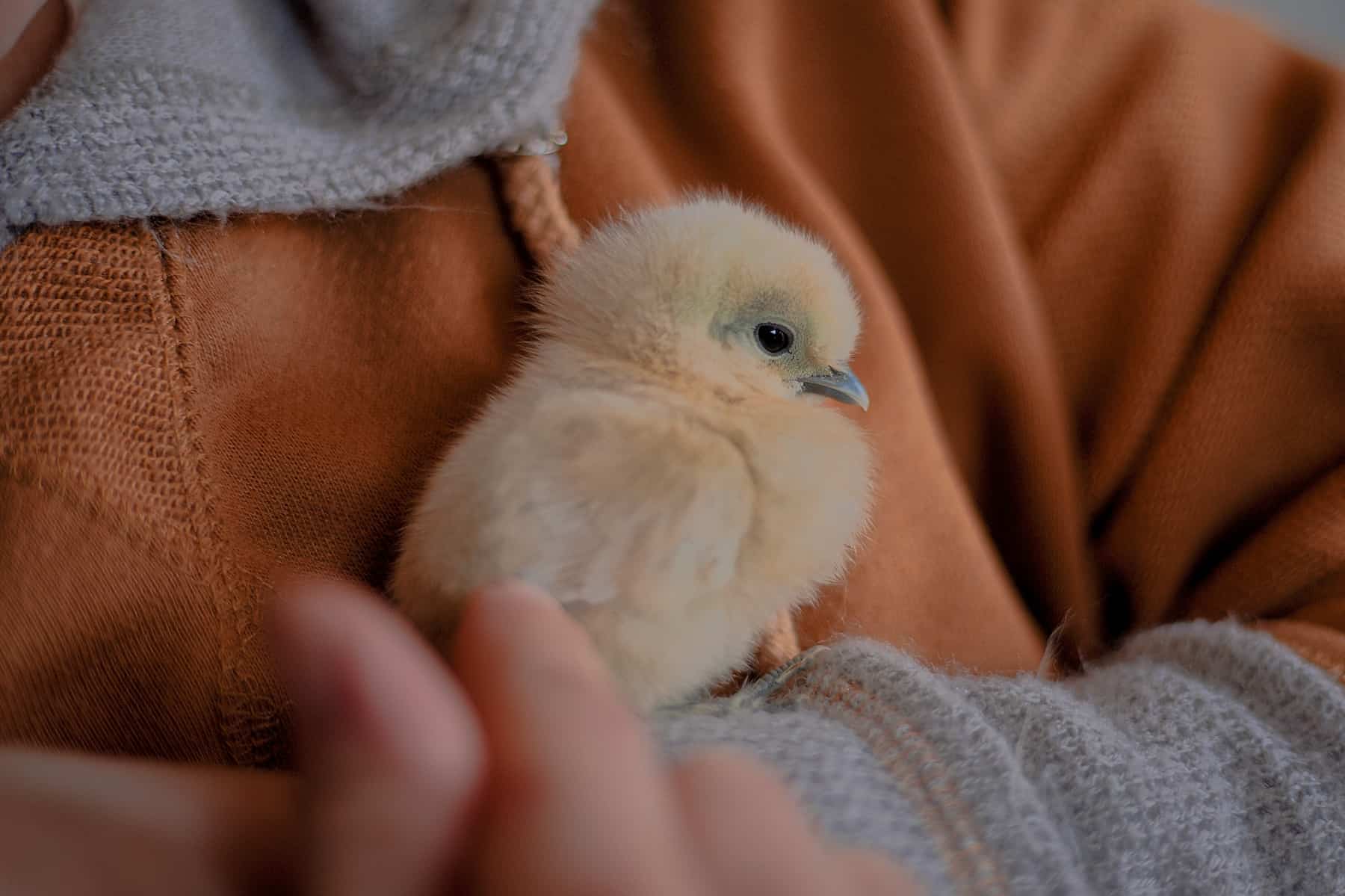
Chick maintenance
Sadly, once in a while a baby chick will get sick or simply fail to thrive. Many times, if you are vigilant in checking your chicks often for problems such as lethargy or pasty vents, you can address these issues and resolve them, saving your chick. This article helps outline basic chick problems and how you can identify and treat them.
Every day or two, I get a couple of helpers and we clean out the whole brooder. The kids hold the chicks (I mean, I can put them in a small box if I need to. But the kids love helping by holding the chicks!) while I take everything out of the brooder, roll up the soiled bedding into the papers on the bottom, and put out fresh papers and chips. This is also a good time to clean the waterer thoroughly with soap and water to prevent bacteria build-up.
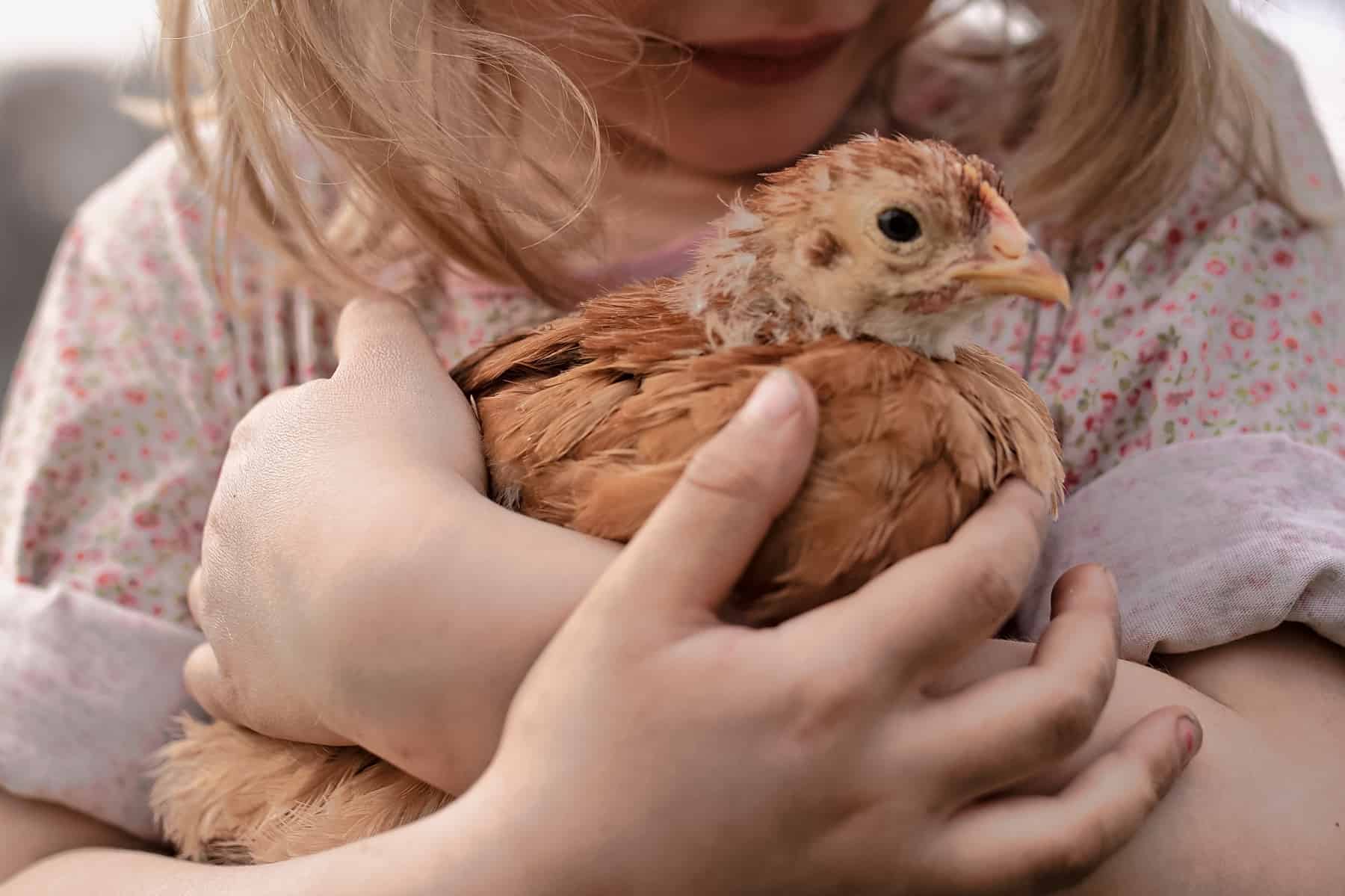
Growing chicks
After a couple of weeks, those tiny fluffballs get a surprising amount of feathers. It doesn’t take long for chicks to hit what we call the “ugly” stage. They get a little gawky and awkward, no longer cute balls of fuzz but far from the lovely plumage of adult birds. At this stage, I put my son in charge of some exercise equipment for the chicks. They love to hop and perch. You can use a dowel rod or even just a straight stick for a roost, and a small cardboard box gives them something to jump on.
Your chicks are also old enough to start feeding some small treats now. Chickens love all kinds of fruits, vegetables, and even table scraps. However, there are a few foods are bad or even toxic to chickens, so be sure to check a list like this one before you start feeding them everything from your fridge!
When you start feeding your chicks treats, make sure you also include a bit of chick grit in their food. Chickens need grit (crushed up bits of rock) to help them digest their food by grinding it up in their crop. Chick starter feed is very digestible, so I don’t add grit until they start foraging for food or getting supplemental treats. Free-range chickens usually find the bits of rock they need for grit in their natural foraging, but I like to toss a bit of grit in their food to just be sure they have what they need.
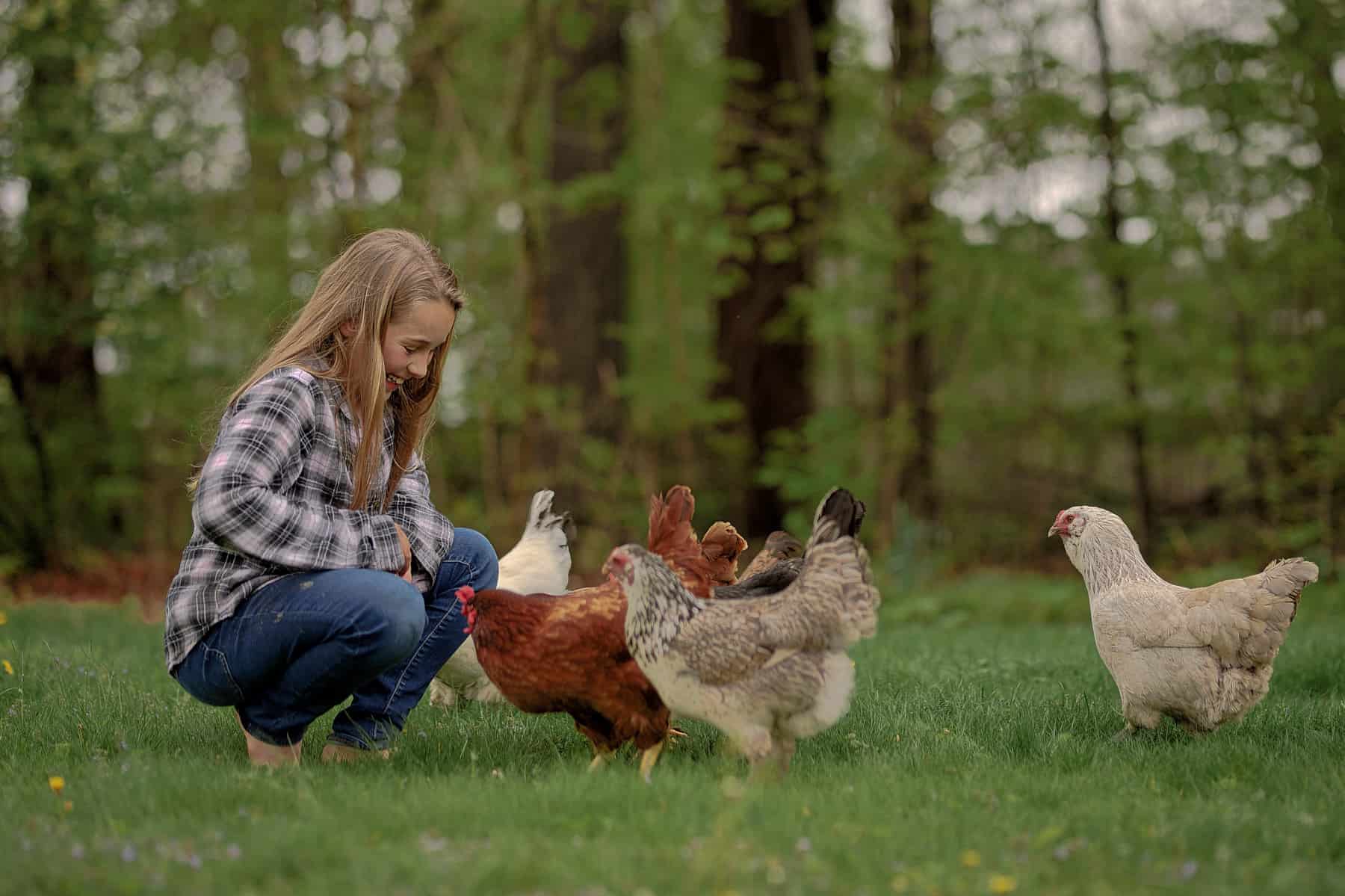
Chicken treats
Our favorite part of feeding treats to the chickens is how much they love it—and consequently, how much they love us. When we step out the back door and call, “Here, chick-chick-chick!” the hens come running from every corner of the yard to see what we have for them. They’ll come up and eat out of our hands and follow us around looking for handouts.
In fact, the other day my daughter was holding a chicken under one arm and eating a cookie (don’t judge! We do try to keep the livestock and the eating separate!), and her siblings say the chicken was taking bites out of one side of her cookie while she ate off the other. I didn’t see it, but I fully believe it. We have more than one hen who will sneak up and take a bite off an unattended plate when we eat outside.
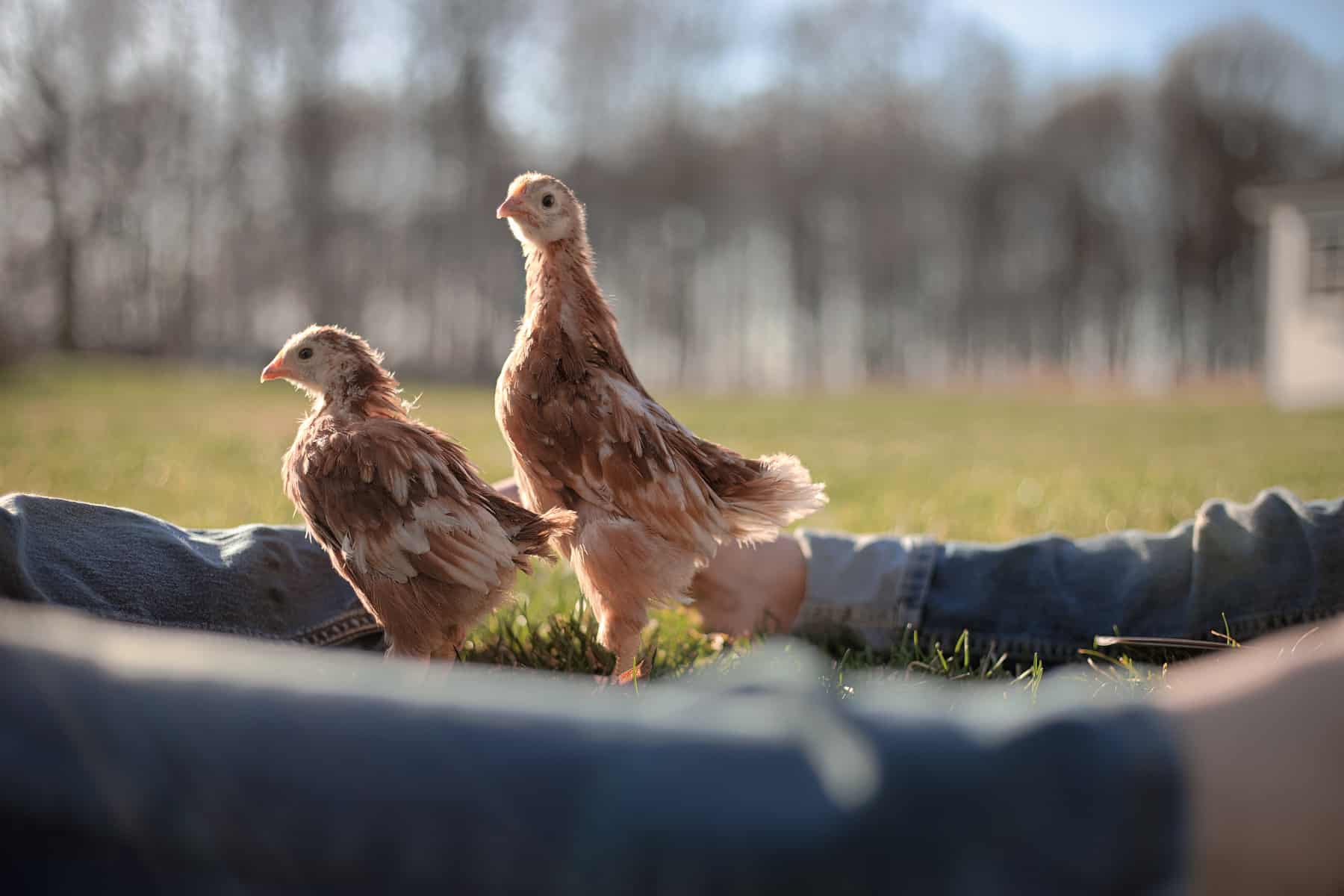
Transitioning chicks outside
I like to start transitioning 4-week-old chicks to outdoor life a little at a time on warm days. They still don’t have enough feathers or mass to maintain their body temperature in cool or windy conditions, but they can handle short visits to the great outdoors. We keep them close to us at first. Usually, the kids sit in the grass and let the chicks peck around in the space between two kids’ outstretched legs. When the chicks start hopping away too quickly, we move them to a portable pet enclosure where they have some freedom.
At first, even just a few minutes outside will wear them out completely. But soon they’re able to spend hours outside when our unpredictable Ohio spring weather permits. We give them a windbreak, their food and water, and watch them carefully. Sometimes one child just gets assigned to chick-watching detail, making sure they are handling the outdoor experience okay and aren’t acting chilled.
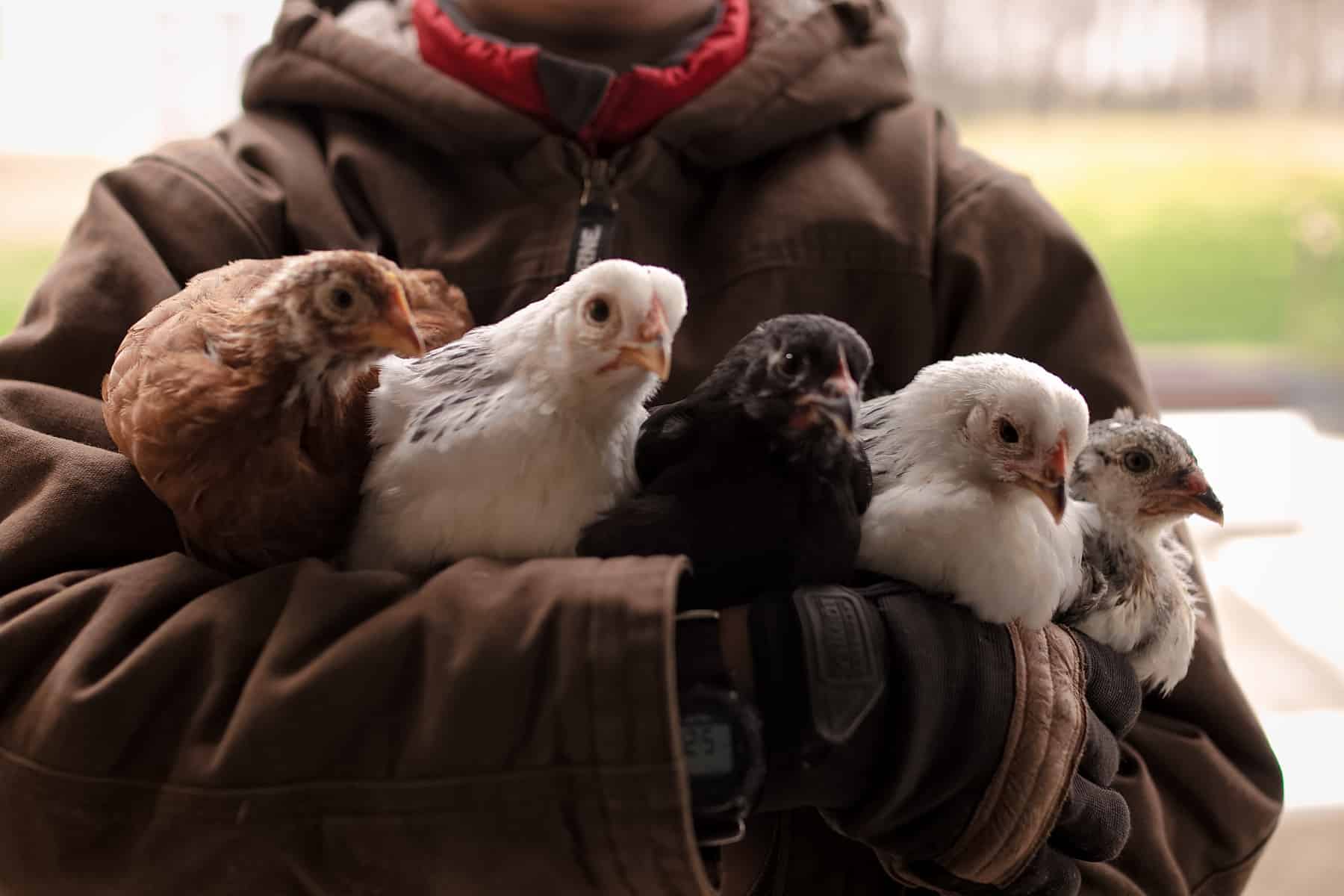
Outdoor chickens
When all the chicks are fully feathered, they are ready to live outside the brooder. You should begin that transition a few weeks before by moving the heat lamp up an inch each week or reducing your brooder temperature by about 5 degrees. This helps them adjust to living without an extra heat source. I’ve noticed that even my biggest chicks love to bask right under the heat lamp whenever they get a chance, even after they no longer need the extra warmth. (Currently I have some standard-sized chicks in with my smaller bantams, so I’ve had to keep the heat lamp available for the little ones. My kids have accused the big chicks of roosting so close to the heat lamp that they’re going to fry their combs!) Moving that heat lamp away slowly toughens them up for outdoor life.
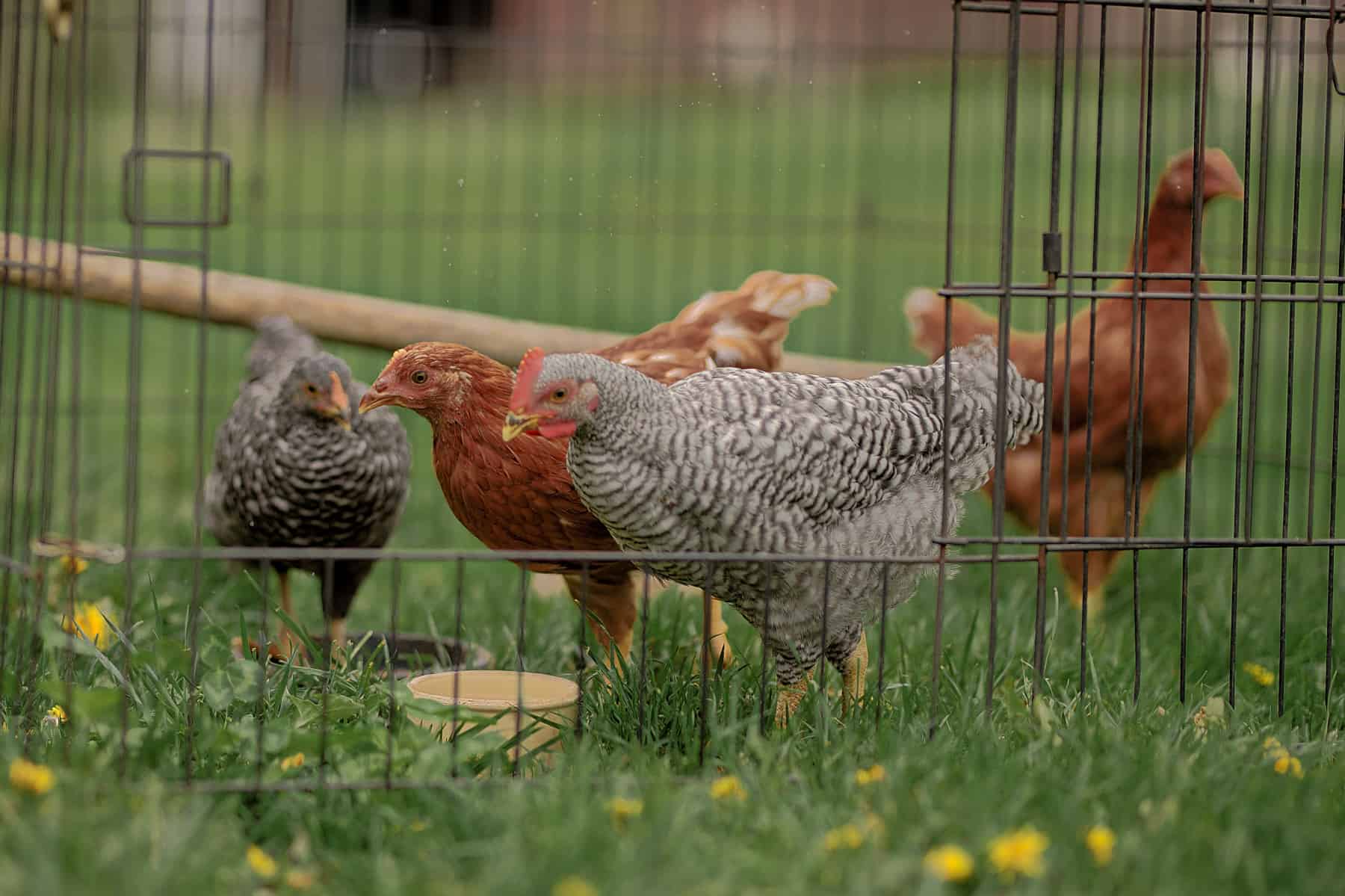
Life in the coop
Now you’re ready for the next step in chicken raising: moving your chicks to the coop. The coop should be secure against predators and draft-free, bedded down with a generous layer of chips and straw. They need a roost to sleep on and some sort of nesting box. And, of course, a supply of feed and water. If your feeder is outside, make sure it sits out of the rain, or you’ll end up with moldy feed very soon!
Even if you plan to let your chickens free-range, you should keep them locked up in the coop/run area for several days so they learn where their home is. Then start letting them loose for short periods of time, keeping an eye on them to make sure they don’t wander too far. Chickens are generally herd animals who stay together and somewhat close to home. They will instinctively go into their coop to roost at dark.
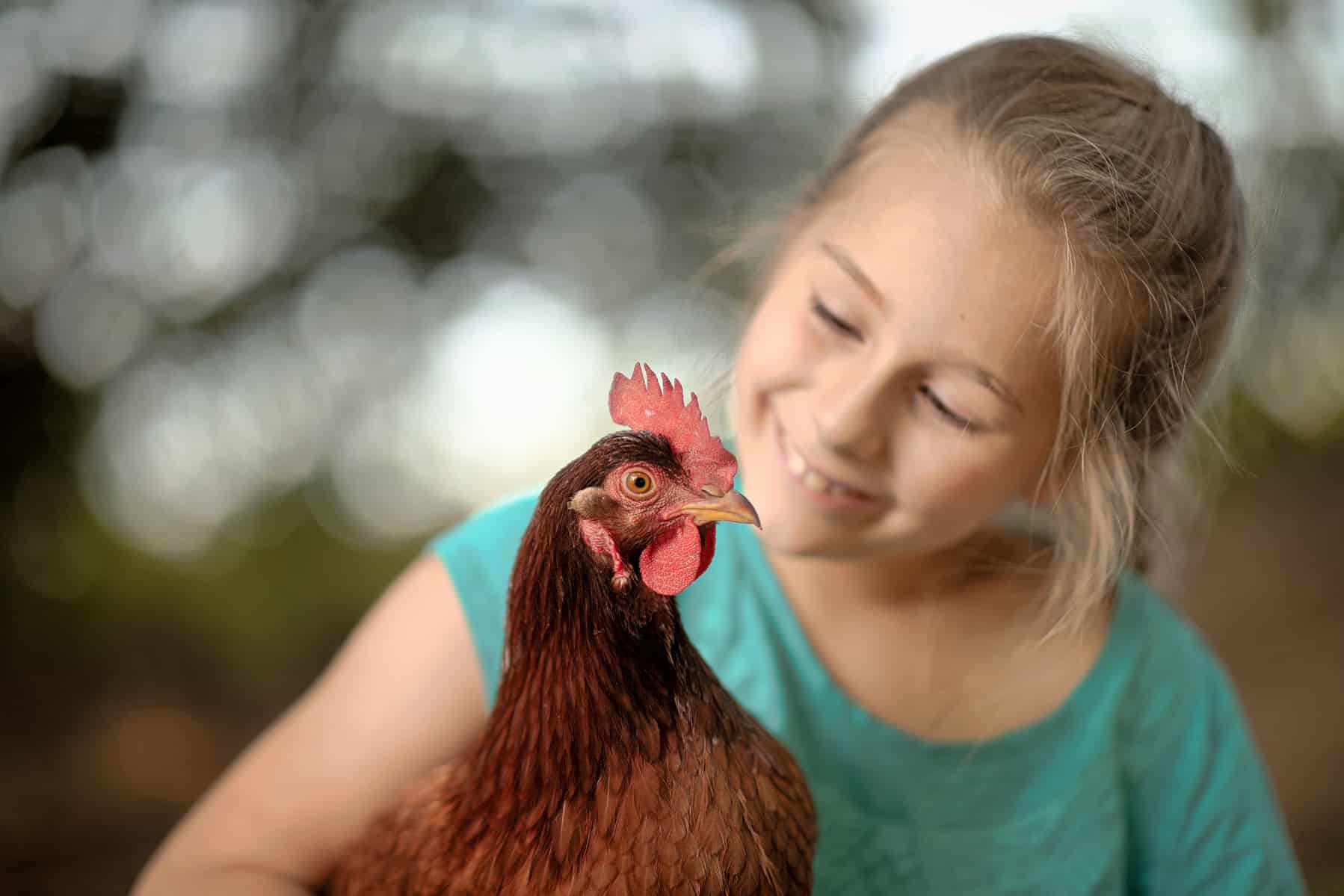
Chicken herding
But when you want to put your chickens up and it ISN’T dark, it takes a little training! Although it sounds impossible, herding chickens into the coop is doable, if you work with them.
First, get your kids involved! This activity requires some helpers. Next, train your chickens to come when you call. Do this at random intervals throughout the day, and make sure there are always treats involved. The children or I walk out the door and yell, “Here, chick-chick-chick!” whenever we have a bread crust or apple peels or any kind of scraps for the chickens. This teaches them to come running when we call. (As a side note, the dog has learned it’s beneficial to get in on the action when we call the chickens, too. He doesn’t want to miss out on anything good!)
When you want to herd the chickens to the coop, have one person walk toward it, calling the chickens and tossing treats. Have a couple of others walk behind the flock, gently herding them in the right direction. As you practice this, the chickens WILL learn the ropes. They might revolt from time to time, but as a general rule, they’ll go into their coop without too much trouble.
The kids will learn their tricks and how to best herd them along, too. I can send my 6 and 9-year-old girls out to put away the hens at any time of day, and they can do it by themselves. We always put our flock away when we’re leaving, both to protect them against predators and to keep them from roaming into the neighbors’ yard.

A word about roosters
A rooster is a fun addition to a flock. They are full of personality and help protect the hens, but they can also have the potential to be aggressive. We had a rooster with our original flock, and we loved him. He was funny, beautiful, and took excellent care of his hens—but he also became aggressive with our little girls. We worked so hard to try to train him not to be mean, but eventually, we had to rehome him to a family with no small children.
Over the years I’ve had both nice and mean roosters. You can’t write off all roosters because of an experience with a mean one, but you also can’t guarantee that a rooster will be nice, even with lots of love. If you get a male with your flock (and sometimes you will get one even if your chicks are all supposed to be females), just be prepared that you may have to deal with an aggressive one. But don’t assume the worst–treat him with love and respect, and hope he’ll respond well! We currently have two suspected roosters mixed in with our young pullets, and we’re loving them up all we can. We’re all hoping for some nice fellows this year.
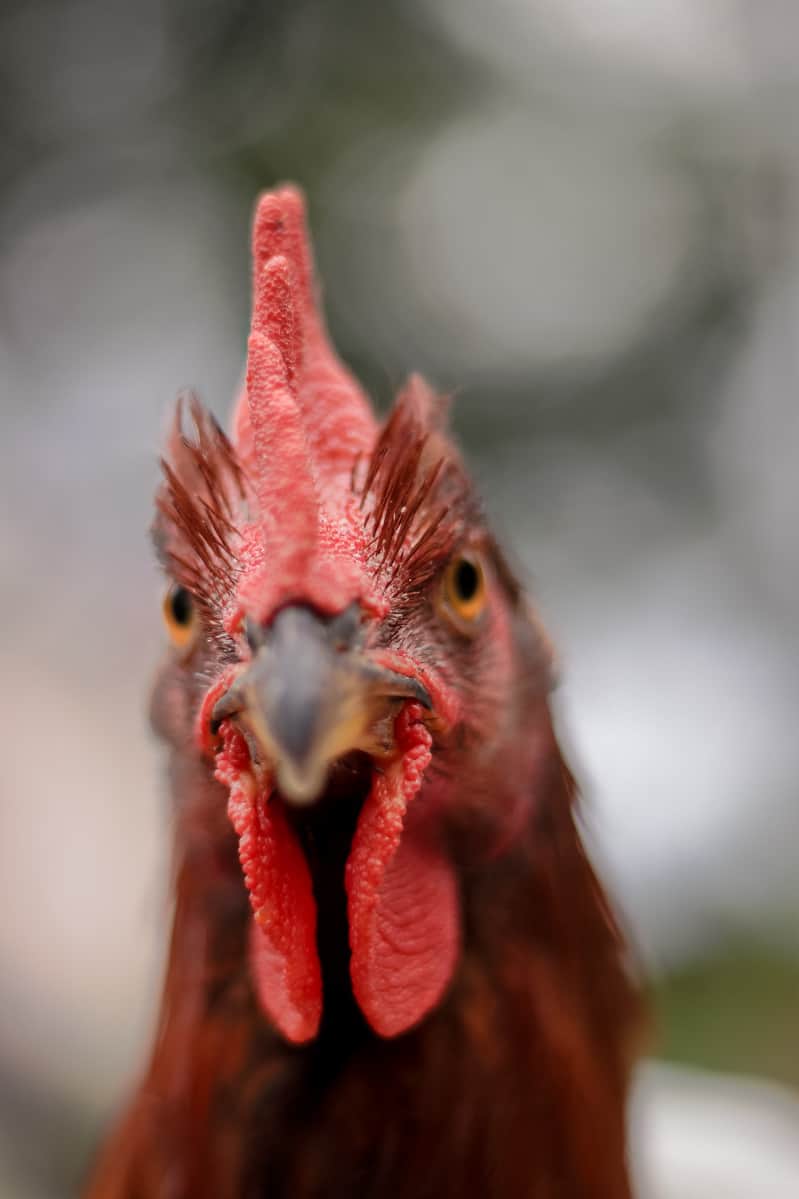
How to handle chicken predators
One of the harder parts of raising chickens is the sad reality of predators. Unfortunately, chickens are an easy mark for any number of predators. Even in suburban areas, you may have to watch out for hawks, owls, and even dogs. Out in the country, we also have to worry about raccoons, foxes, and coyotes.
The best way to protect your birds is to make sure their coop is secure from top to bottom. Latch them in every night at dusk to protect again nocturnal invaders. Make sure their fenced area is as secure as you can make it, with sturdy walls and some sort of mesh or wire covering.
But if you let your chickens free-range, you have to realize that they may be exposed to predators. Quite unexpectedly, we had a red-tailed hawk swoop right up to the back edge of our yard and kill a hen last year. It was a heartbreaking experience for all of us. Although it was something of a freak event that we couldn’t have expected or prevented, it also reminded us of the importance of caring well for these somewhat helpless creatures. Our chickens depend on us to look after them and keep them safe–that’s part of the responsibility of pet/livestock ownership.
Sometimes illness or accident will still strike our animals, but I’m trying to teach my children to be good caretakers of our animal friends. We do our best to provide them with a safe, healthy home. In return, they provide us with endless entertainment, fun, and a wonderful supply of delicious eggs.
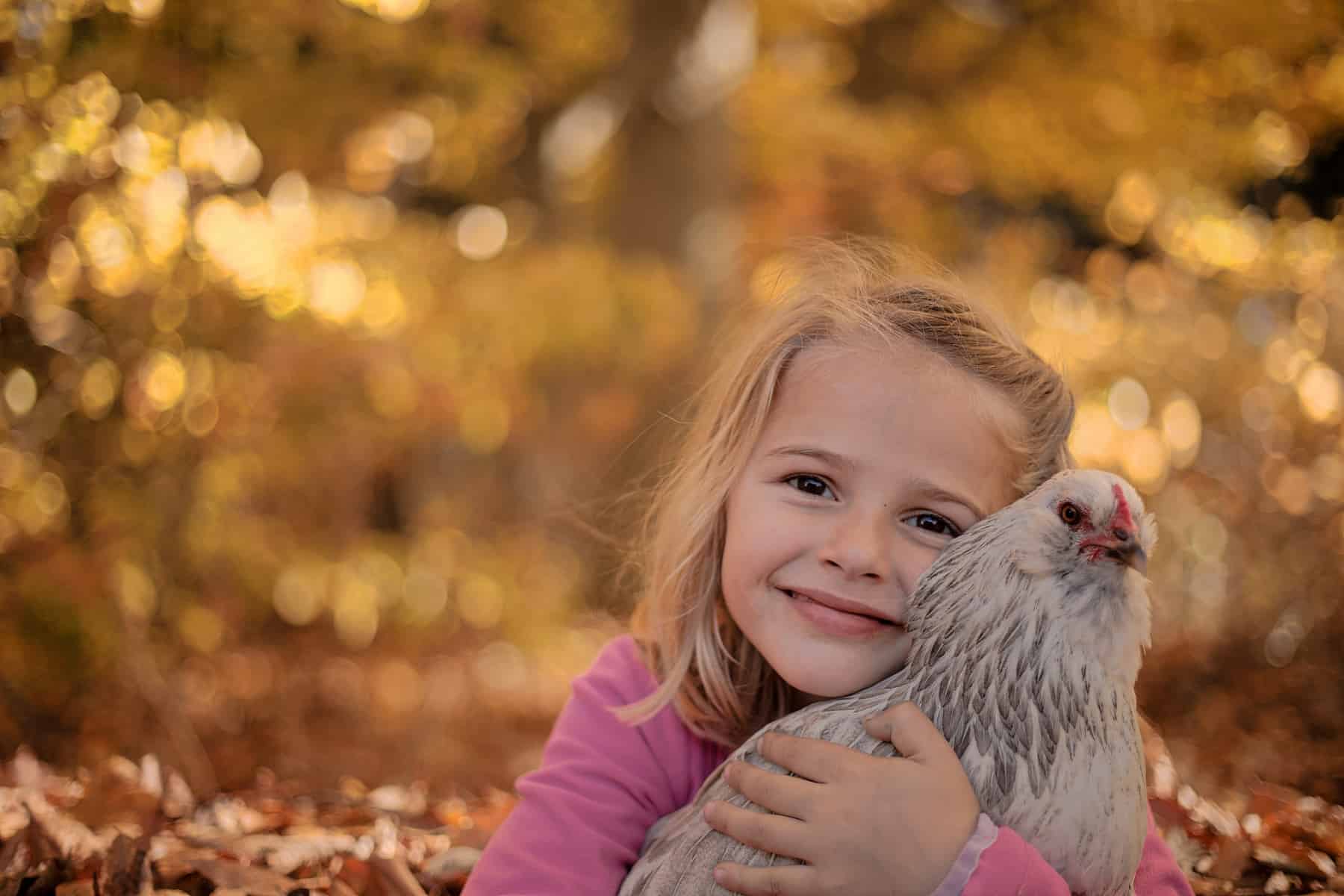
Have you ever considered raising chickens?
Let us know if you have any questions about chickens and kids.
About the author
Leslie is an Ohio farm girl and chaser of light, children, and sometimes chickens. She’s a lover of Jesus, wife to her high school sweetheart, and a homeschooling mom of four wild rascals who love the great outdoors as much as she does. As a family, they love hiking, camping, fishing, and just about any outdoor activity. She and her husband are just beginning the process of building a homestead from the ground up, doing most of the work themselves. Leslie has a lifelong obsession with writing and capturing everyday life from behind the lens. You can follow along with their homesteading, homeschooling, and everyday adventures on her Instagram account.
You can find more from Leslie in the following locations:
Instagram: @c_l_allofus
Client work: @lalvisphotography
Leslie’s RWMC posts: Owling with Kids, Homemade Apple Butter, Dealing with Poison Ivy, Mosquitoes & Ticks, Creating Nature Fairy Gardens, Eco-Friendly Bird Feeders, Getting Kids Outside During the School Year, Pond Nature Study, Maple Syrup with Kids, Cattle Farm Chores









Hi! I am seriously considering getting a few backyard chickens! I went so far as to order a coop online, but then I starting researching vaccines for the chicks, which led me down a rabbit hole of all the diseases they can carry and how children under 5 shouldn’t be around chickens. I have a 2 year old and a 5 year old and was planning on letting the chicks roam the yard during the day. I am now having serious reservations…. any advice?
What, if anything, do you do to help mitigate spreading germs or illness from chickens to humans other than washing hands? My mother-in-law and husband are concerned that one of the kids will inevitably get sick or track chicken poop in the house. We live in the suburbs and plan the have the coop in our backyard and have our flock of 4 (this fall) to free range occasionally. I’m not too worried but eager to hear your experience with managing this element of life with chickens and kids!